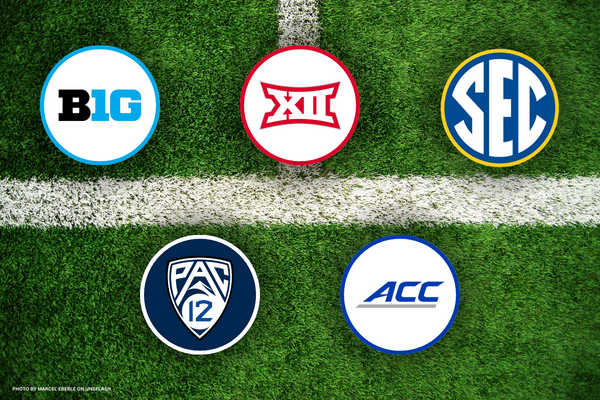Let’s be real — if you’ve ever watched a Saturday packed with college football or tuned in during bowl season, chances are you’ve heard about the “Power 5.” It’s a buzzword in every sports conversation, but what does it actually mean? More importantly, why should you care?
Whether you’re a high school athlete weighing your options, a parent navigating scholarship talks, or just a fan trying to make sense of the college sports landscape, understanding the Power 5 gives you a serious edge.
So, What Is the Power 5?
The Power 5 refers to five powerhouse athletic conferences in NCAA Division I that dominate the college football (and broader college sports) world. These aren’t just your average conferences — they’re the ones with the biggest budgets, loudest stadiums, and strongest national influence.
Here’s who makes the cut:
-
ACC (Atlantic Coast Conference)
-
Big Ten Conference
-
Big 12 Conference
-
Pac-12 Conference
-
SEC (Southeastern Conference)
These conferences house some of the most iconic college programs in the U.S. — think Alabama, Ohio State, Georgia, USC, Michigan, and Clemson. And when it comes to national championships, Heisman winners, or ESPN’s primetime slots? Yeah, it’s almost always someone from the Power 5.
A Brief Backstory: Where Did the Power 5 Come From?
College athletic conferences have been around for over 100 years, but the term “Power 5” didn’t really catch fire until the past couple of decades. It emerged as these five leagues began pulling ahead in terms of revenue, recruiting, and media attention.
From early regional matchups to today’s billion-dollar TV deals, the Power 5 story is all about evolution. And lately, with major schools switching conferences (hello, Texas and Oklahoma to the SEC; USC and UCLA to the Big Ten), the college football map is getting redrawn in real time.
What’s constant, though, is that the Power 5 sets the tone — competitively and financially.
Why the Power 5 Matters (Way More Than You Might Think)
💰 Big Money, Big Moves
These conferences rake in massive revenue from television contracts, sponsorships, and ticket sales. Networks like ESPN, FOX, and CBS throw down billions just to air these games. The result? State-of-the-art facilities, fat coaching salaries, and deep athletic resources.
🎓 Not Just Sports — Prestige Too
Most Power 5 schools also have serious academic clout. We’re talking top research institutions, elite alumni networks, and name-brand prestige. For student-athletes, this combo of sports and education is hard to beat.
👀 Visibility = Opportunity
Games from these conferences are nationally televised almost every week. That means athletes get more exposure, scouts take more notice, and fans get deeper invested. If you’re trying to make it to the NFL (or even get a solid college experience), a Power 5 school gives you a much bigger platform.
What About the “Group of Five”?
If there’s a Power 5, there has to be… the rest, right?
Enter the Group of Five — smaller FBS conferences that include:
-
American Athletic Conference (AAC)
-
Sun Belt
-
Mid-American Conference (MAC)
These conferences still produce great teams (looking at you, Cincinnati and UCF), but they don’t get the same level of media coverage, revenue, or playoff access. That gap is why the Power 5’s dominance continues to grow — and why realignment and playoff expansion are such hot-button issues.
The Power of Television (And Why It Shapes Everything)
TV money is the real game-changer. The Power 5 conferences have leveraged media rights into multi-billion-dollar empires. Just look at:
-
The SEC’s blockbuster deal with ESPN
-
The Big Ten’s historic media rights agreement with FOX, CBS, and NBC
-
The Big 12 and ACC launching their own conference networks
These aren’t just content deals — they’re financial engines. They allow schools to recruit top talent, promote athletic programs aggressively, and expand their digital and in-person fanbases year-round.
Recruiting Wars and the Power 5 Edge
Ask any top high school football player where they want to play — chances are, they’re eyeing a Power 5 school. Why? Because those schools offer:
-
Greater national exposure
-
Better facilities and training support
-
Higher likelihood of competing in the College Football Playoff
-
More chances of being seen by NFL scouts
This cycle — top athletes choose Power 5 → Power 5 dominates → media pays more — keeps the Power 5 schools firmly in the driver’s seat.
The Future of the Power 5: Expansion, Realignment & Super Conferences?
The landscape isn’t static. We’re entering a phase where super conferences could become the norm. With teams constantly switching affiliations and playoff structures evolving, we may see a version of college football in 2030 that looks very different from today.
Some experts believe the Power 5 might even split from the NCAA entirely one day, creating their own governing structure with new rules and revenue sharing models.
One thing’s certain: change is coming — and fast.
Final Thoughts: Why It All Matters for Fans, Athletes, and Events
Whether you’re following the College Football Playoff, planning to attend a bowl game, or just love the culture of Saturdays in the fall, the Power 5 is where most of the action happens.
At Events Notification, we track Power 5-related sports events, fan fests, and conferences across the country. So if you’re looking for high-impact NCAA events, major rivalry games, or future athlete showcases, this is the zone to watch.



